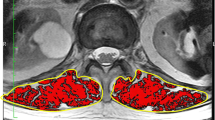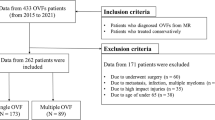Abstract
Summary
This study revealed the change in the paravertebral muscles in patients with osteoporotic vertebral fracture. Increased pain is likely to be the driver for reduced activity, reduced activities of daily living, and consequent increase in fat infiltration of the paravertebral muscles, assumed to be secondary to reduced activity level or, conversely, partial immobilization.
Introduction
To reveal the time courses and impact of the paravertebral muscles (PVMs) on the healing process of osteoporotic vertebral fractures and risk factors for PVM decrease.
Methods
Consecutive patients with symptomatic osteoporotic vertebral fractures were enrolled in 11 hospitals. At enrollment and 3- and 6-month follow-up, PVMs, including the multifidus and erector spinae, were examined using magnetic resonance imaging (MRI). The PVM cross-sectional area (CSA) and fat signal fraction (FSF) were measured at L3. Low back pain (LBP), activities of daily living (ADLs), and risk factors for PVM decrease at the 6-month follow-up were investigated. PVM decrease was defined as > 1 standard deviation decrease of the CSA or > 1 standard deviation increase of the FSF.
Results
Among 153 patients who completed the 6-month follow-up, 117 (92 women, 79%) had MRI of L3 at enrollment and 3- and 6-month follow-up (mean age at enrollment, 78.5 years). The CSA did not change 6 months from onset (p for trend = 0.634), whereas the FSF significantly increased (p for trend = 0.033). PVM decrease was observed in 30 patients (26%). LBP was more severe, and delayed union was more frequent in patients with PVM decrease (p = 0.021 mixed-effect model and p = 0.029 chi-square test, respectively). The risk factors for PVM decrease were ADL decline at the 3-month follow-up (adjusted odds ratio = 5.35, p = 0.026).
Conclusion
PVM decrease was significantly related to LBP and delayed union after osteoporotic vertebral fracture onset. ADL decline at the 3-month follow-up was a risk factor for PVM decrease. Therefore, restoring ADLs within 3 months after onset is important.
Similar content being viewed by others
References
Horii C, Asai Y, Iidaka T, Muraki S, Oka H, Tsutsui S, Hashizume H, Yamada H, Yoshida M, Kawaguchi H, Nakamura K, Akune T, Tanaka S, Yoshimura N (2019) Differences in prevalence and associated factors between mild and severe vertebral fractures in Japanese men and women: the third survey of the ROAD study. J Bone Miner Metab 37(5):844–853. https://doi.org/10.1007/s00774-018-0981-5
Cooper C, Atkinson EJ, Jacobsen SJ, O’Fallon WM, Melton LJ 3rd (1993) Population-based study of survival after osteoporotic fractures. Am J Epidemiol 137(9):1001–1005. https://doi.org/10.1093/oxfordjournals.aje.a116756
Tosteson AN, Gabriel SE, Grove MR, Moncur MM, Kneeland TS, Melton LJ 3rd (2001) Impact of hip and vertebral fractures on quality-adjusted life years. Osteoporos Int 12(12):1042–1049. https://doi.org/10.1007/s001980170015
Sinaki M, Pfeifer M, Preisinger E, Itoi E, Rizzoli R, Boonen S, Geusens P, Minne HW (2010) The role of exercise in the treatment of osteoporosis. Curr Osteoporos Rep 8(3):138–144. https://doi.org/10.1007/s11914-010-0019-y
Hoshino M, Tsujio T, Terai H, Namikawa T, Kato M, Matsumura A, Suzuki A, Takayama K, Takaoka K, Nakamura H (2013) Impact of initial conservative treatment interventions on the outcomes of patients with osteoporotic vertebral fractures. Spine (Phila Pa 1976) 38(11):E641–E648. https://doi.org/10.1097/BRS.0b013e31828ced9d
Kim HJ, Yi JM, Cho HG, Chang BS, Lee CK, Kim JH, Yeom JS (2014) Comparative study of the treatment outcomes of osteoporotic compression fractures without neurologicinjury using a rigid brace, a soft brace, and no brace a prospective randomized controlled non-inferiority trial. J Bone Joint Surg Am 96(23):1959–1966. https://doi.org/10.2106/JBJS.N.00187
Matsumoto T, Hoshino M, Tsujio T, Terai H, Namikawa T, Matsumura A, Kato M, Toyoda H, Suzuki A, Takayama K, Takaoka K, Nakamura H (2012) Prognostic factors for reduction of activities of daily living following osteoporotic vertebral fractures. Spine (Phila Pa 1976) 37(13):1115–1121. https://doi.org/10.1097/BRS.0b013e3182432823
Takahashi S, Hoshino M, Takayama K, Iseki K, Sasaoka R, Tsujio T, Yasuda H, Sasaki T, Kanematsu F, Kono H, Toyoda H, Nakamura H (2016) Predicting delayed union in osteoporotic vertebral fractures with consecutive magnetic resonance imaging in the acute phase: a multicenter cohort study. Osteoporos Int 27(12):3567–3575. https://doi.org/10.1007/s00198-016-3687-3
Hori Y, Hoshino M, Inage K, Miyagi M, Takahashi S, Ohyama S, Suzuki A, Tsujio T, Terai H, Dohzono S, Sasaoka R, Toyoda H, Kato M, Matsumura A, Namikawa T, Seki M, Yamada K, Habibi H, Salimi H, Yamashita M, Yamauchi T, Furuya T, Orita S, Maki S, Shiga Y, Inoue M, Inoue G, Fujimaki H, Murata K, Kawakubo A, Kabata D, Shintani A, Ohtori S, Takaso M, Nakamura H (2019) ISSLS PRIZE IN CLINICAL SCIENCE 2019: clinical importance of trunk muscle mass for low back pain, spinal balance, and quality of life-a multicenter cross-sectional study. Eur Spine J 28(5):914–921. https://doi.org/10.1007/s00586-019-05904-7
Hebert JJ, Kjaer P, Fritz JM, Walker BF (2014) The relationship of lumbar multifidus muscle morphology to previous, current, and future low back pain: a 9-year population-based prospective cohort study. Spine (Phila Pa 1976) 39(17):1417–1425. https://doi.org/10.1097/BRS.0000000000000424
Yagi M, Hosogane N, Watanabe K, Asazuma T, Matsumoto M, Keio Spine Research Group (2016) The paravertebral muscle and psoas for the maintenance of global spinal alignment in patient with degenerative lumbar scoliosis. Spine J 16(4):451–458. https://doi.org/10.1016/j.spinee.2015.07.001
DiGirolamo DJ, Kiel DP, Esser KA (2013) Bone and skeletal muscle: neighbors with close ties. J Bone Miner Res 28(7):1509–1518. https://doi.org/10.1002/jbmr.1969
Sinaki M, Mikkelsen BA (1984) Postmenopausal spinal osteoporosis: flexion versus extension exercises. Arch Phys Med Rehabil 65(10):593–596
Sinaki M, Itoi E, Wahner HW, Wollan P, Gelzcer R, Mullan BP, Collins DA, Hodgson SF (2002) Stronger back muscles reduce the incidence of vertebral fractures: a prospective 10 year follow-up of postmenopausal women. Bone 30(6):836–841. https://doi.org/10.1016/S8756-3282(02)00739-1
Sinaki M, Brey RH, Hughes CA, Larson DR, Kaufman KR (2005) Significant reduction in risk of falls and back pain in osteoporotic-kyphotic women through a spinal proprioceptive extension exercise dynamic (SPEED) program. Mayo Clin Proc 80(7):849–855. https://doi.org/10.4065/80.7.849
Kim JY, Chae SU, Kim GD, Cha MS (2013) Changes of paraspinal muscles in postmenopausal osteoporotic spinal compression fractures: magnetic resonance imaging study. J Bone Metab 20(2):75–81. https://doi.org/10.11005/jbm.2013.20.2.75
So KY, Kim DH, Choi DH, Kim CY, Kim JS, Choi YS (2013) The influence of fat infiltration of back extensor muscles on osteoporotic vertebral fractures. Asian Spine J 7(4):308–313. https://doi.org/10.4184/asj.2013.7.4.308
Takahashi S, Hoshino M, Takayama K, Iseki K, Sasaoka R, Tsujio T, Yasuda H, Sasaki T, Kanematsu F, Kono H, Toyoda H, Nakamura H (2017) Time course of osteoporotic vertebral fractures by magnetic resonance imaging using a simple classification: a multicenter prospective cohort study. Osteoporos Int 28(2):473–482. https://doi.org/10.1007/s00198-016-3737-x
Hu ZJ, He J, Zhao FD, Fang XQ, Zhou LN, Fan SW (2011) An assessment of the intra- and inter-reliability of the lumbar paraspinal muscle parameters using CT scan and magnetic resonance imaging. Spine (Phila Pa 1976) 36(13):868–874. https://doi.org/10.1097/BRS.0b013e3181ef6b51
Crawford RJ, Filli L, Elliott JM, Nanz D, Fischer MA, Marcon M, Ulbrich EJ (2016) Age- and level-dependence of fatty infiltration in lumbar paravertebral muscles of healthy volunteers. AJNR Am J Neuroradiol 37(4):742–748. https://doi.org/10.3174/ajnr.A4596
Shahidi B, Parra CL, Berry DB, Hubbard JC, Gombatto S, Zlomislic V, Allen RT, Hughes-Austin J, Garfin S, Ward SR (2017) Contribution of lumbar spine pathology and age to paraspinal muscle size and fatty infiltration. Spine (Phila Pa 1976) 42(8):616–623. https://doi.org/10.1097/BRS.0000000000001848
Teichtahl AJ, Urquhart DM, Wang Y, Wluka AE, Wijethilake P, O'Sullivan R, Cicuttini FM (2015) Fat infiltration of paraspinal muscles is associated with low back pain, disability, and structural abnormalities in community-based adults. Spine J 15(7):1593–1601. https://doi.org/10.1016/J.SPINEE.2015.03.039
Elliott J, Jull G, Noteboom JT, Darnell R, Galloway G, Gibbon WW (2006) Fatty infiltration in the cervical extensor muscles in persistent whiplash-associated disorders. Spine (Phila Pa 1976) 31(22):E847–E855. https://doi.org/10.1097/01.brs.0000240841.07050.34
Paalanne N, Niinimäki J, Karppinen J, Taimela S, Mutanen P, Takatalo J, Korpelainen R, Tervonen O (2011) Assessment of association between low back pain and paraspinal muscle atrophy using opposed-phase magnetic resonance imaging: a population-based study among young adults. Spine (Phila Pa 1976) 36(23):1961–1968. https://doi.org/10.1097/BRS.0b013e3181fef890
Mengiardi B, Schmid MR, Boos N, Pfirrmann CW, Brunner F, Elfering A, Holder J (2006) Fat content of lumbar paraspinal muscles in patients with chronic low back pain and in asymptomatic volunteers: quantification with MR spectroscopy. Radiology 240(3):786–792. https://doi.org/10.1148/radiol.2403050820
Hebert JJ, Kjaer P, Fritz JM, Walker BF (2014) The relationship of lumbar multifidus muscle morphology to previous, current, and future low back pain: a 9-year population-based prospective cohort study. Spine (Phila Pa 1976) 39(17):1417–1425. https://doi.org/10.1097/BRS.0000000000000424
Appell HJ (1990) Muscular atrophy following immobilisation. A review. Sports Med 10(1):42–58. https://doi.org/10.2165/00007256-199010010-00005
Walsh NE, Schwartz RK (1990) The influence of prophylactic orthoses on abdominal strength and low back injury in the workplace. Am J Phys Med Rehabil 69(5):245–250. https://doi.org/10.1097/00002060-199010000-00004
Briggs AM, Greig AM, Bennell KL, Hodges PW (2007) Paraspinal muscle control in people with osteoporotic vertebral fracture. Eur Spine J 16(8):1137–1144. https://doi.org/10.1007/s00586-006-0276-8
Funding
This study was funded by the Grant of Japan Orthopedics and Traumatology Research Foundation (Grant no. 270).
Author information
Authors and Affiliations
Corresponding author
Ethics declarations
Conflict of interest
None.
Ethical approval
This study was approved by the Ethics Committee of Osaka City University. All procedures performed in studies involving human participants were in accordance with the ethical standards of the institutional and/or national research committee and with the 1964 Declaration of Helsinki and its later amendments or comparable ethical standards.
Informed consent
Informed consent was obtained from all participants included in the study.
Additional information
Publisher’s note
Springer Nature remains neutral with regard to jurisdictional claims in published maps and institutional affiliations.
Electronic supplementary material
ESM 1
(DOCX 1235 kb)
Rights and permissions
About this article
Cite this article
Takahashi, S., Hoshino, M., Takayama, K. et al. The natural course of the paravertebral muscles after the onset of osteoporotic vertebral fracture. Osteoporos Int 31, 1089–1095 (2020). https://doi.org/10.1007/s00198-020-05338-8
Received:
Accepted:
Published:
Issue Date:
DOI: https://doi.org/10.1007/s00198-020-05338-8




